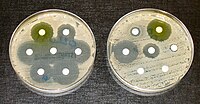
Photo from wikipedia
Environmental influences on antibiotic activity and resistance can wreak havoc with in vivo antibiotic efficacy and, ultimately, antimicrobial chemotherapy. In nature, bacteria encounter a variety of metal ions, particularly copper… Click to show full abstract
Environmental influences on antibiotic activity and resistance can wreak havoc with in vivo antibiotic efficacy and, ultimately, antimicrobial chemotherapy. In nature, bacteria encounter a variety of metal ions, particularly copper (Cu) and zinc (Zn), as contaminants in soil and water, as feed additives in agriculture, as clinically-used antimicrobials, and as components of human antibacterial responses. Importantly, there is a growing body of evidence for Cu/Zn driving antibiotic resistance development in metal-exposed bacteria, owing to metal selection of genetic elements harbouring both metal and antibiotic resistance genes, and metal recruitment of antibiotic resistance mechanisms. Many classes of antibiotics also form complexes with metal cations, including Cu and Zn, and this can hinder (or enhance) antibiotic activity. This review highlights the ways in which Cu/Zn influence antibiotic resistance development and antibiotic activity, and in so doing impact in vivo antibiotic efficacy.
Journal Title: Trends in microbiology
Year Published: 2017
Link to full text (if available)
Share on Social Media: Sign Up to like & get
recommendations!